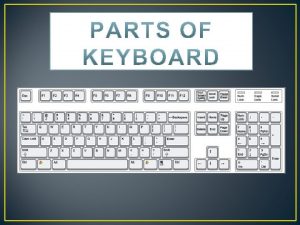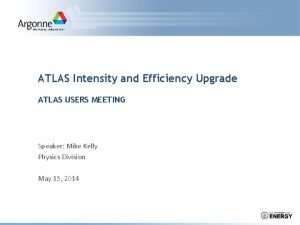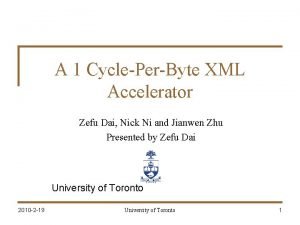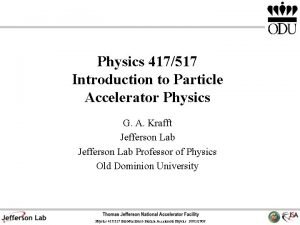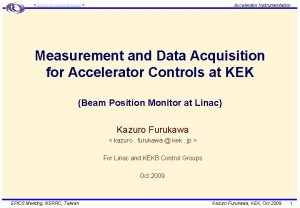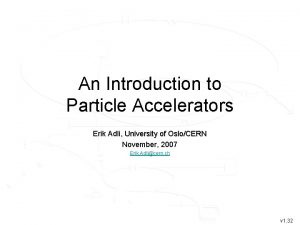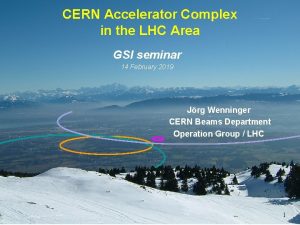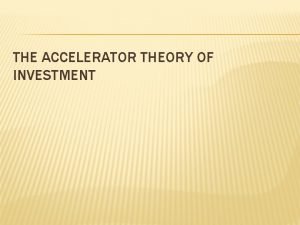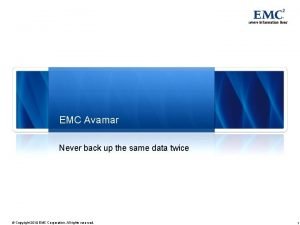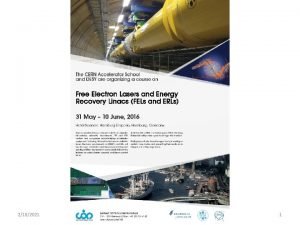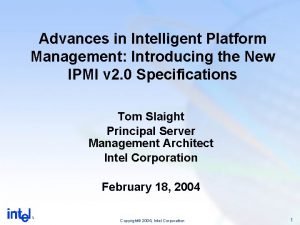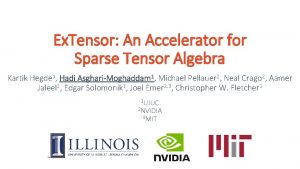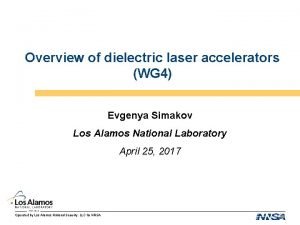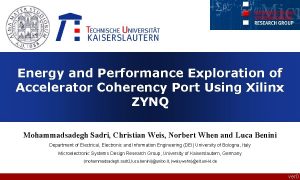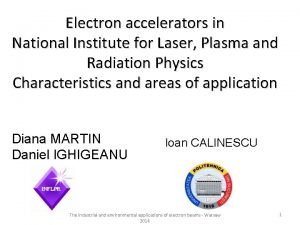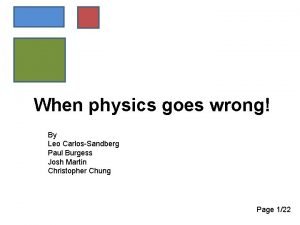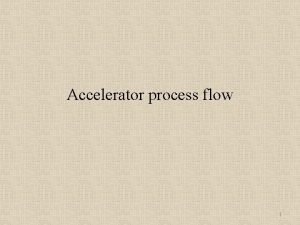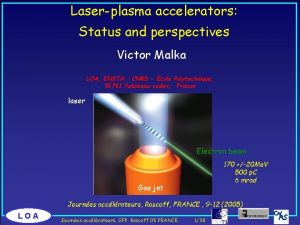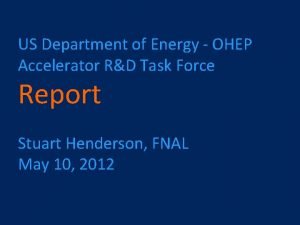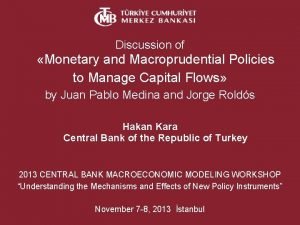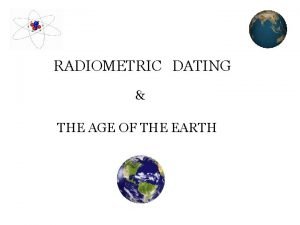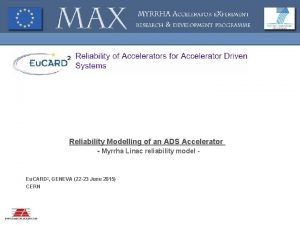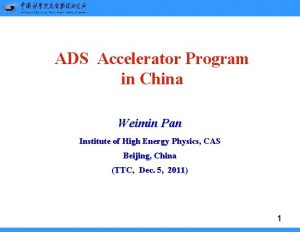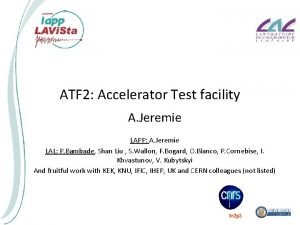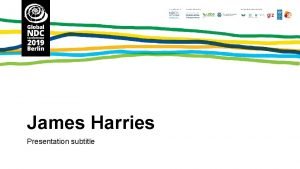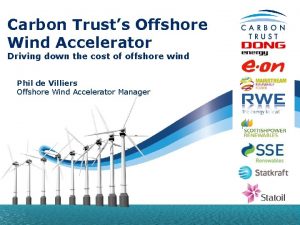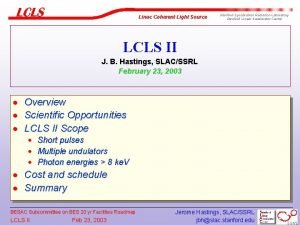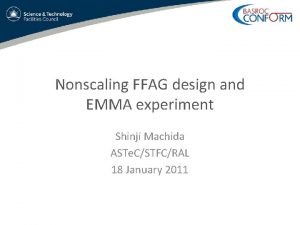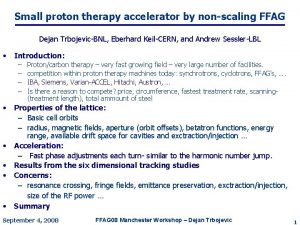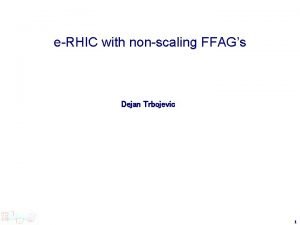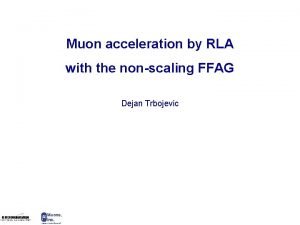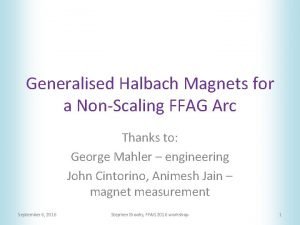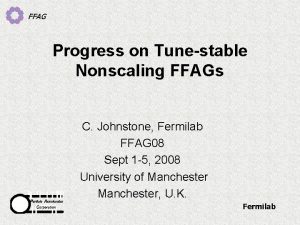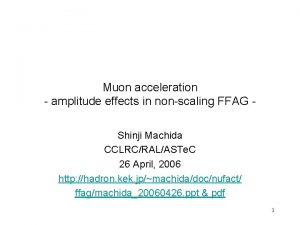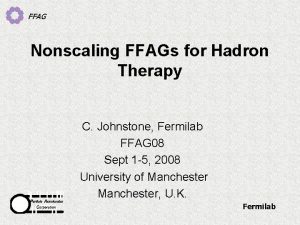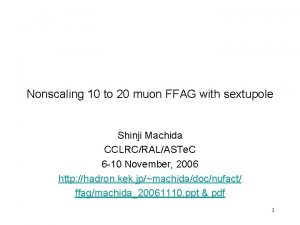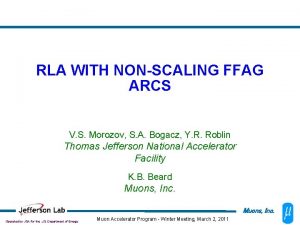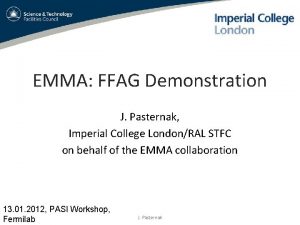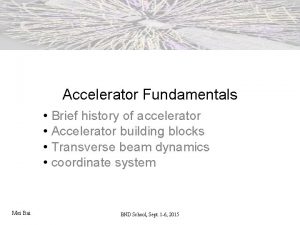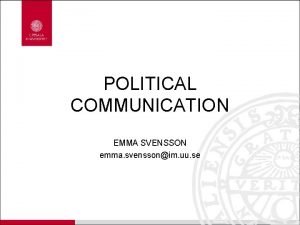EMMA the Worlds First NonScaling FFAG Accelerator Susan
















































- Slides: 48

EMMA the World's First Non-Scaling FFAG Accelerator Susan Smith STFC Daresbury Laboratory

CONTENTS EMMA Sept 2009 Susan Louise Smith

• • • Contents Introduction What are ns-FFAGs? and Why EMMA? The international collaboration EMMA goals and requirements Hardware requirements – – Layout and lattice Magnets and magnet challenges Diagnostics Radio frequency • Experiments • Summary EMMA Sept 2009 Susan Louise Smith

INTRODUCTION EMMA Sept 2009 Susan Louise Smith

Project Overview BASROC (The British Accelerator Science and Radiation Oncology Consortium, BASROC) • CONFORM project ( COnstruction of a Non-scaling FFAG for Oncology, Research, and Medicine ) • 4 year project April 2007 – March 2011 • 3 parts to the project – EMMA design and construction ~ £ 6. 5 m (~$9 M) Electron Model for Many Applications (EMMA) – PAMELA design study – Applications study EMMA Sept 2009 Susan Louise Smith

Applications of ns-FFAGs Neutrino Factory Proton & Carbon Therapy High power proton driver Dedicated Muon Source EMMA Sept 2009 Sub-critical Thorium Reactor Roger & Sam Susan Louise Smith

WHAT ARE NON-SCALING FFAGS? WHY EMMA? EMMA Sept 2009 Susan Louise Smith

Scaling FFAGs • Fixed Fields => Rapid acceleration • Alternating Gradient =>Reduced magnet apertures compared to cyclotron • Large 6 D acceptance – High average and peak beam currents • Beam can be extracted at a number of energies • Fixed tunes • Fixed orbit shape (largely increases with radius) • Variable time of flight EMMA Sept 2009 Susan Louise Smith

Non-scaling FFAG • Born from considerations of very fast muon acceleration – – Breaks the scaling requirement More compact orbits ~ X 10 reduction in magnet aperture Betatron tunes vary with acceleration (resonance crossing) Parabolic variation of time of flight with energy • Factor of 2 acceleration with constant RF frequency • Serpentine acceleration • Can mitigate the effects of resonance crossing by: – Fast Acceleration ~15 turns – Linear magnets (avoids driving strong high order resonances) • Or nonlinear magnets (avoids crossing resonances) – Highly periodic, symmetrical machine (many identical cells) • Tight tolerances on magnet errors d. G/G <2 x 10 -4 Novel, unproven concepts which need testing Electron Model => EMMA! EMMA Sept 2009 Susan Louise Smith

Muon Acceleration Model • EMMA was originally conceived as a model of a 10 -20 Ge. V muon accelerator • Designed to demonstrate that linear non-scaling optics work and to make a detailed study of the novel features of this type of machine • Variable tunes with acceleration • Parabolic variation of time of flight with energy - Serpentine acceleration EMMA Sept 2009 Susan Louise Smith

THE INTERNATIONAL COLLABORATION EMMA Sept 2009 Susan Louise Smith

EMMA International Collaboration • EMMA design is an international effort and we recognise and appreciate the active collaboration from: – Brookhaven National Laboratory – Cockcroft Institute UK – Fermi National Accelerator Laboratory – John Adams Institute UK – LPSC, Grenoble – Science & Technology Facilities Council UK – TRIUMF – ………. . EMMA Sept 2009 Susan Louise Smith

EMMA GOALS AND REQUIREMENTS EMMA Sept 2009 Susan Louise Smith

EMMA Goals Graphs courtesy of Scott Berg BNL EMMA Sept 2009 Susan Louise Smith

Lattice Configurations Understanding the NS-FFAG beam dynamics as function of lattice tuning & RF parameters Tune plane • Example: retune lattice to vary resonances crossed during acceleration Time of Flight vs Energy • Example: retune lattice to vary longitudinal Time of Flight curve, range and minimum Graphs courtesy of Scott Berg BNL EMMA Sept 2009 Susan Louise Smith

Accelerator Requirements • Injection & extraction at all energies , 10 - 20 Me. V • Fixed energy operation to map closed orbits and tunes vs momentum • Many lattice configurations – Vary ratio of dipole to quadrupole fields – Vary frequency, amplitude and phase of RF cavities • Map longitudinal and transverse acceptances with probe beam EMMA to be heavily instrumented with beam diagnostics EMMA Sept 2009 Susan Louise Smith

LAYOUT AND LATTICE EMMA Sept 2009 Susan Louise Smith

ALICE Accelerators and Lasers In Combined Experiments Parameter Value Nominal Gun Energy 350 ke. V Injector Energy 8. 35 Me. V Max. Energy 35 Me. V Linac RF Frequency GHz 1. 3 Max Bunch Charge 80 p. C Emittance 5 -15 mm-mrad EMMA Sept 2009 Susan Louise Smith

EMMA Parameters & Layout Energy range 10 – 20 Me. V Lattice F/D Doublet Circumference 16. 57 m No of cells 42 Normalised transverse acceptance 3π mm-rad Frequency (nominal) 1. 3 GHz No of RF cavities 19 Repetition rate 1 - 20 Hz Bunch charge 16 -32 p. C single bunch EMMA Sept 2009 Susan Louise Smith

EMMA Ring 90 k. W IOT racks RF distribution 17 hybrid and phase shifter waveguide modules Injection Septum 65° Kicker Extraction Septum 70° Kicker Septum Power Supply Wire Scanner ~5 m Wall Current Monitor Kicker Power Supplies RF Cavities x 19 YAG Screen Septum Power Supply Septum & kicker power supplies EMMA Sept 2009 Kicker Power Supplies YAG Screen Wire Scanner D Quadrupole x 42 F Quadrupole x 42 BPM x 82 16 Vertical correctors Susan Louise Smith

EMMA Ring Cell 65 mm 55 mm D F Low Energy Beam Cavity High Energy Beam stay clear aperture D Long drift 210 mm F Quad 58. 8 mm Short drift 50 mm D Quad 75. 7 mm 42 identical cells • Cell length 395 mm • 110 mm 210 mm Centre-lines Magnet EMMA Sept 2009 Susan Louise Smith

A 6 Cell Girder Assembly F Magnet D Magnet Location for diagnostics Cavity Ion Pump Girder ion ct e r i d m a e B EMMA Sept 2009 Susan Louise Smith

EMMA Ring Section Field clamp plates BPM 2 per cell Vertical QD Corrector Standard vacuum chamber per 2 cells Bellows ction Beam dire QF Cavity EMMA Sept 2009 Location for diagnostic screen and vacuum pumping Susan Louise Smith

MAGNETS & MAGNET CHALLENGES EMMA Sept 2009 Susan Louise Smith

Ring Quadrupole Magnets Requirements / Design • Adjust dipole & quadrupole components independently – Mount magnets on independent radial linear slides • Fields identical in every cell despite kickers and septum – Field clamps at cell entrance face of QD & exit face of QF • Very large good field region for range of orbits – Optimised pole profile Field clamp plates QF QD Linear slides EMMA Sept 2009 Susan Louise Smith

Prototype Ring Magnets D-magnet • Good field gradient quality requirement is ± 1. 0% over a good gradient region of – QF +15. 8, -32. 0 mm – QD - 56. 0 , -9. 9 mm EMMA Sept 2009 Susan Louise Smith

Injection & Extraction • • Large angle for injection (65°) and extraction (70°) very challenging !! Injection/Extraction scheme required for all energies (10 – 20 Me. V) Many lattices and many configurations of each lattice required Very limited space between quadrupole clamp plates for the septum and kickers construction Extensive 3 D magnet modelling conducted to minimise the effect of stray septum fields on circulating beam In je ct io Kicker EMMA Sept 2009 Kicker Septum 65° n Susan Louise Smith

Injection Region In je ct io EMMA Sept 2009 Kicker Septum 65° n Susan Louise Smith

n tio a l s an Tr Rotation Septum with vacuum chamber removed Septum Design Maximum beam deflection angle 77 degrees Maximum flux density in gap 0. 91 T C core magnet gap height 22. 0 mm Internal horizontal beam ‘stay-clear’ 62. 5 mm Turns on excitation coil 2 Excitation half-sine-wave duration 25 µs Excitation peak current 9. 1 k. A Excitation peak voltage 900 V Septum magnet repetition rate 20 Hz • Inject/Extracts from 10 -20 Me. V • For all lattice configurations Section view of septum in vacuum chamber EMMA Sept 2009 Susan Louise Smith

Kicker Maximum beam deflection 105 m. R Horizontal good field region 23 mm Minimum vertical gap at the beam 25 mm Horizontal deflection quality 1 % Minimum flat-top (+0, -1% ) 5 ns < 50 ns 20 Hz Field rise/fall time (100% to 1%) Kicker magnet repetition rate • Inject/Extracts from 10 -20 Me. V • For all lattice configurations (Amplitude range including polarity changes) • Explore the large EMMA horizontal acceptance • Correction initial horizontal trajectory during acceleration EMMA Sept 2009 Susan Louise Smith

Kicker Magnet, Fast Switching Magnet length Field at 10 Me. V (Injection) Field at 20 Me. V (Extraction) 0. 1 m 0. 035 T 0. 07 T Magnet Inductance 0. 25 H Lead Inductance 0. 16 H Peak Current at 10/20 Me. V 1. 3 k. A Peak Voltage at Magnet 14 k. V Peak Voltage at Power Supply 23 k. V Rise / Fall Time 50 n. S Jitter pulse to pulse < 2 n. S Pulse Waveform EMMA Sept 2009 Kicker Magnet Power Supply parameters With compact design and require: • Fast rise / fall times 50 n. S • Rapid changes in current 50 k. A/ S • Constraints on pre and post pulses ½ Sinewave Susan Louise Smith

DIAGNOSTICS EMMA Sept 2009 Susan Louise Smith

Diagnostics (1) Measurement Device Number Required resolution Beam position 4 button BPM 2/plane/cell in ring 4 in injection 3 in extraction 50 m Beam profile OTR / YAG screens Beam profile Beam current Wire scanners Wall current monitor 2 in ring 1 WCM 1 scope 10 m 2% Phase Transmission WCM As above 10° 2% EMMA Sept 2009 2 in ring, 6 in injection 20 -30 m pixel & extraction line size Susan Louise Smith

Diagnostics (2) Measurement Device Number Bunch charge Faraday cup 1 at injection, 1 at extraction 4 in ring Beam loss Momentum Emittance Extracted momentum Longitudinal profile EMMA Sept 2009 Beam loss monitor BPMs and TOF Already included from WCMs elsewhere Tomography Injection & extraction diagnostic lines Spectrometer 1 (diagnostics line) Electro-Optic system 1 (diagnostics line) Required resolution 2% 2% 100 ke. V 10% 1% <1 ps Susan Louise Smith

EMMA Ring Wall Current Monitor Wire Scanner Septum Power Supply Kicker Power Supplies YAG Screen Wire Scanner YAG Screen e. BPM x 82 EMMA Sept 2009 Susan Louise Smith

EMMA INJECTION LINE 30° Dipole BPM at dipole entrance ct io n Wall Current Monitor YAG screen &vertical slit YAG screen B ea m D EMMA Ring New Quadrupoles x 13 ALICE 30° Dipole ire Vacuum valve & BPM YAG screen Tomography Section YAG screens x 3 Emittance measurement Vacuum valve SRS Quadrupoles x 5 Vertical Steering Magnet x 2 33° Dipoles x 2 BPM at dipole entrance EMMA Sept 2009 Faraday cup Beam dump Combined horizontal and vertical steering magnet x 4 Susan Louise Smith

DIAGNOSTICS BEAMLINE LAYOUT EMMA Sept 2009 Susan Louise Smith

Electron Beam Position Monitors • The BPM electronics system has to deliver 50 m resolution over a large aperture • Locally mounted coupler cards – Amplifies signals from opposite buttons, coupler and strip line delay cables give a 12 ns delay, signals combined in single high quality coax • Detector card in rack room outside of shielded area – Prototype tested and moving to a VME style card design EMMA Sept 2009 Prototype Coupler RF Detector, Clock Control and ADC Susan Louise Smith

Vacuum chamber & BPM Standard vacuum chambers each covering 2 cells 4 x BPM bodies, accurately machined and welded into vacuum chamber BPM Bellows BPM Ø 48 m m Standard vacuum chamber. Material stainless steel EMMA Sept 2009 ± 25 m r. m. s. resolution required BPM block cross-section showing pickups Susan Louise Smith

RADIO FREQUENCY EMMA Sept 2009 Susan Louise Smith

RF Requirements • Voltage: – 20 - 120 k. V/cavity essential, based on 19 cavities – Up to 180 k. V/cavity desirable (future upgrade) • Frequency: – 1. 3 GHz, compact and matches the ALICE RF system – Range requirement 5. 6 MHz • Cavity phase: – Remote and individual control of the cavity phases is essential EMMA Sept 2009 Susan Louise Smith

Cavity Design 110 mm Parameter Frequency 1. 3 GHz Input coupling loop Theoretical Shunt Impedance 2. 3 M Coolant channels Realistic Shunt Impedance (80%) Aperture Ø 40 mm Qo (Theoretical) 23, 000 R/Q 100 Ω Tuning Range -4 to +1. 6 MHz Accelerating Voltage 120 k. V Probe Capacitive post tuner Total Power Required (Assuming 30% losses in distribution Power required per Normal conducting single cell re-entrant cavity design optimised for high shunt impedance EMMA Sept 2009 Value 2 M 90 k. W 3. 6 k. W Susan Louise Smith

RF Source • A single 100 k. W (pulsed) IOT supplying the 19 RF cavities distributed around EMMA • VIL 409 high power RF amplifier system in 3 racks CPI 100 k. W (pulsed) IOT EMMA Sept 2009 Susan Louise Smith

Cascade RF Distribution • 17 hybrid and phase shifter modules located around the EMMA ring in a cascade configuration splitting the RF power equally to 19 cavities RF coaxial cable to RF cavity Hybrid EMMA Sept 2009 Susan Louise Smith

Low Level RF • Stability of the accelerating field is provided by the LLRF • Includes hardware and software to optimise the amplitude and phase during operation and for the frequency of operation to be set • LLRF tests have been completed using: – CPI IOT at power level 5 k. W – 2 EMMA cavities – Power split equally using a 3 d. B hybrid and phase shifter waveguide module – Amplitude stability 0. 006% (spec. 0. 3%) – Phase stability 0. 009 o (spec. 0. 3 o) EMMA Sept 2009 Susan Louise Smith

SUMMARY EMMA Sept 2009 Susan Louise Smith

Summary • • • NS-FFAGs are a novel untested concept EMMA is a model for that concept The EMMA experiment will test that concept The technical design is complete All major subsystems have been defined and designed to meet the requirements of the experiment A key aim is to: Show non scaling FFAG acceleration works, compare results with theoretical studies and gain real experience of operating such accelerators The next step will be to apply the lessons learnt to new applications! EMMA Sept 2009 Susan Louise Smith

Acknowledgements All the team – STFC, Cockcroft Institute & John Adams Institute staff – International Collaborators – Commercial suppliers EMMA Sept 2009 Susan Louise Smith
 Worlds together worlds apart 4th edition
Worlds together worlds apart 4th edition Who invented the first computer keyboard
Who invented the first computer keyboard Atlas accelerator module
Atlas accelerator module Xml accelerator
Xml accelerator Coherent accelerator processor interface
Coherent accelerator processor interface Physics
Physics Medical particle accelerator
Medical particle accelerator Fiscal policy definition
Fiscal policy definition Accelerator
Accelerator Sap citizen engagement accelerator
Sap citizen engagement accelerator Compost accelerator homebase
Compost accelerator homebase Stanford linear accelerator tours
Stanford linear accelerator tours Proton
Proton Cern accelerator complex
Cern accelerator complex Criticism of accelerator theory of investment
Criticism of accelerator theory of investment Emc avamar data store
Emc avamar data store Cern accelerator school 2021
Cern accelerator school 2021 Intelligent platform management interface industry
Intelligent platform management interface industry Extensor: an accelerator for sparse tensor algebra
Extensor: an accelerator for sparse tensor algebra Dielectric wall accelerator
Dielectric wall accelerator Salesforce cpq accelerator
Salesforce cpq accelerator Accelerator coherency port
Accelerator coherency port Microsoft virtual machine converter solution accelerator
Microsoft virtual machine converter solution accelerator Dielectric laser accelerator
Dielectric laser accelerator Vmware backup best practices
Vmware backup best practices Burgoski
Burgoski Biztalk swift
Biztalk swift Growth accelerator coach
Growth accelerator coach Charter network accelerator
Charter network accelerator Netbackup accelerator
Netbackup accelerator Loa accelerator
Loa accelerator Sandra biedron
Sandra biedron Financial accelerator
Financial accelerator Tca color accelerator drops
Tca color accelerator drops United way social innovation accelerator
United way social innovation accelerator Project dtf reality kings
Project dtf reality kings Accelerator mass spectrometry
Accelerator mass spectrometry Ads accelerator
Ads accelerator Netbackup track log location
Netbackup track log location Ads accelerator
Ads accelerator Accelerator
Accelerator Climate finance accelerator
Climate finance accelerator Talent accelerator program
Talent accelerator program Offshore wind accelerator
Offshore wind accelerator Stanford
Stanford Uplogix 500
Uplogix 500 Grasp model
Grasp model ưu thế lai là gì
ưu thế lai là gì Tư thế ngồi viết
Tư thế ngồi viết

